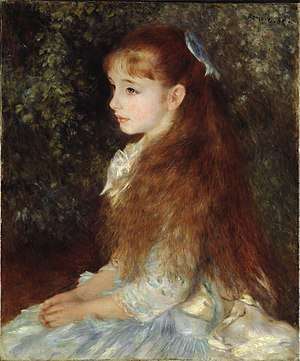Portrait of Irène Cahen d'Anvers
The Portrait of Irène Cahen d’Anvers, or The Little Girl with the Blue Ribbon (French: La Petite Fille au ruban bleu) or Little Irène (French: La Petite Irène), is an oil painting by French Impressionist artist Pierre-Auguste Renoir.
| Portrait of Irène Cahen d'Anvers | |
|---|---|
| La Petite Irène | |
 | |
| Artist | Pierre-Auguste Renoir |
| Year | c. 1880 |
| Medium | Oil on canvas |
| Subject | Irène Cahen d'Anvers |
| Dimensions | 65 cm × 54 cm (26 in × 21 in) |
| Location | Foundation E.G. Bührle, Zürich |
Commissioned by the wealthy French Jewish banker Louis Cahen d'Anvers in 1880, the painting depicts his daughter Irène Cahen d'Anvers at the age of 8. During World War II, the painting was stolen by the Nazis during their organized looting of European countries. In 1946 it resurfaced and was exhibited in Paris as one of the "French masterpieces found in Germany". In 2014, it appeared in the movie The Monuments Men as one of the pieces of art saved by the Monuments, Fine Arts, and Archives program.
History
In the 1870s-80s, Renoir frequently painted portraits for the families of the Parisian Jewish community. Through the collector Charles Ephrussi, proprietor of the Gazette des Beaux-Arts, Renoir met Louis Cahen d'Anvers. The Cahen d'Anvers family was one of the wealthiest Jewish banking families in Paris.[1] In 1880, Louis Cahen d'Anvers commissioned two portraits of his three daughters, the eldest of which was Irène. The younger daughters Alice and Elizabeth would become the subject of a later painting by Renoir, now commonly known as Pink and Blue.
The Portrait of Irène Cahen d'Anvers, also commonly called Little Irene, is considered today as one of Renoir's masterpieces. At the time, for an unknown reason, Louis was so dissatisfied with the painting that he hung it in the servants' quarters and delayed Renoir's payment of 1500 francs.[2]
In 1883, the painting was first exhibited in the first exhibition dedicated exclusively to Renoir, held in Paul Durand-Ruel's Boulevard des Capucines gallery. In 1910 the painting was purchased by the wealthy Camondo family, which Irène had married into in 1891.
After the fall of France, the painting was looted from Château de Chambord by the Nazis. Like many other important pieces of European art, it became a part of Hermann Göring's personal collection. In 1946, Portrait of Irène Cahen d'Anvers resurfaced and was exhibited in Paris as one of the "French masterpieces found in Germany". The painting along with dozens of other artwork stolen by the Nazis was later acquired by Emil Georg Bührle, a Swiss industrialist, art collector of German origin and CEO of the armaments company Oerlikon, a wartime supplier of the German military.[3] The painting remains part of the E.G. Bührle Collection in Zürich.
In 2014, it appeared in the movie The Monuments Men as one of the pieces of art saved by the Monuments, Fine Arts, and Archives program. In 2018, Little Irène gained popularity in Japan when it was exhibited in the National Art Center in Tokyo, as part of a series on Impressionist artworks on loan from the E.G. Bührle Collection.[4]
Irène Cahen d’Anvers
Irène Cahen d’Anvers (1872–1963), the subject of this painting, was 8 years old at the time of the portrait. The eldest daughter of the wealthy Jewish French banker Count Louis Cahen d'Anvers, she married Count Moïse de Camondo in 1891. They separated in August 1897 after her affair with de Camondo's stable master, Count Charles Sampieri, whom she would later marry and divorce.
Irène had two children with de Camondo, Nissim and Béatrice. During World War I Nissim became a fighter pilot of the French Air Force and was killed in action in 1917 over Lorraine.[5] In 1935, Moïse de Camondo bequeathed his Parisian mansion, at 63 rue de Monceau, including its contents and a major collection of art, to the Musée des Arts Décoratifs to be used to create the Musée Nissim de Camondo in honour of his and Irène's son. During World War II, Béatrice, her ex-husband and their two children were murdered by the Nazis in Auschwitz because of their Jewish ancestry.[6] As her daughter Béatrice's sole inheritor, Irène received the large de Camondo fortune. Irène also had a daughter with Sampieri, Claude, who would marry the French fighter ace and race car driver André Dubonnet. Irène lived until 1963 and died in Paris, aged 91.
Notes
- The Hare with the Amber Eyes - Edmund de Waal p. 44.
- Nord, Philip G. (2000). Impressionists and Politics: Art and Democracy in the Nineteenth Century. London: Routledge. p. 60. ISBN 041507715X.
- "La Petite Fille Au Ruban Bleu". elisabethitti.fr.
- ""自撮り"NGの名画「可愛いイレーヌ」【コラム】". Artne.jp.
- "Nissim de Camondo". Les Arts Decoratifs.
- Michlin, Gilbert (2004). Of no Interest to the Nation: A Jewish Family in France, 1925–1945. Wayne State University Press. p. 122. ISBN 978-0-8143-3227-6.
References
- Julian, Ph. Rose' de Renoir retrouvé. In: Le Figaro littéraire. Paris, 1962, pp. 22.